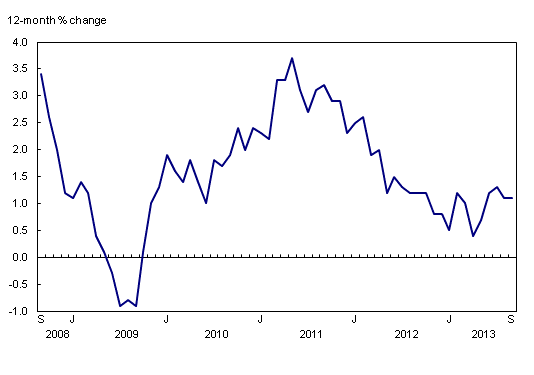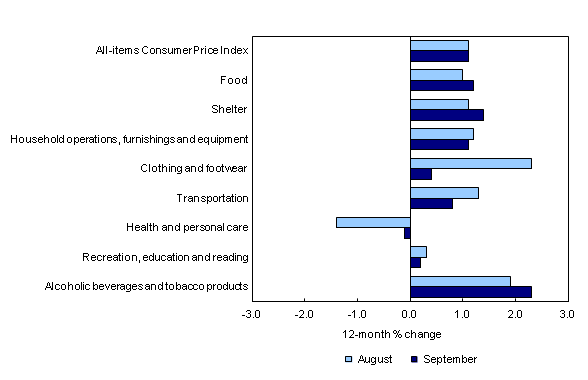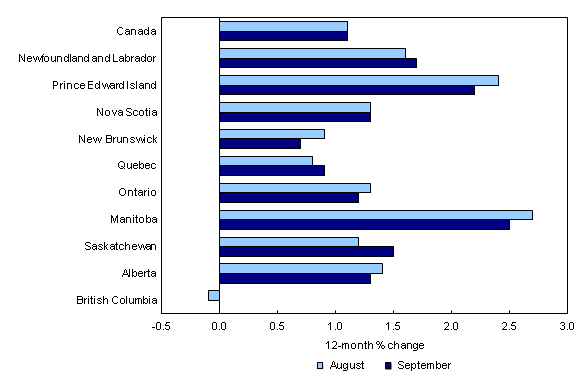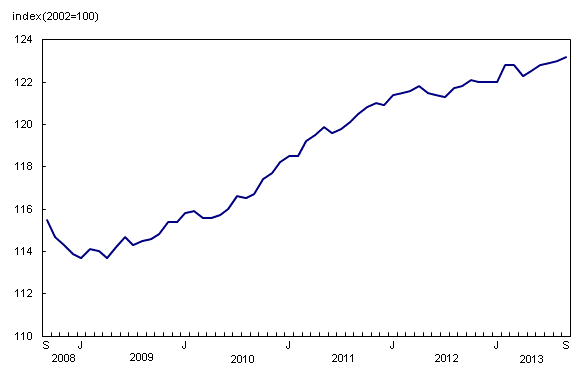Consumer Price Index, September 2013
Archived Content
Information identified as archived is provided for reference, research or recordkeeping purposes. It is not subject to the Government of Canada Web Standards and has not been altered or updated since it was archived. Please "contact us" to request a format other than those available.
Released: 2013-10-18
The Consumer Price Index (CPI) rose 1.1% in the 12 months to September, matching the increase in August.
12-month change in the major components
In September, seven of the eight major components posted year-over-year increases. Higher shelter costs led the rise in the CPI. Year-over-year price increases for food and transportation were also contributing factors. The health and personal care index was the only major component to decline in September compared with the same month a year ago.
Shelter costs rose 1.4% on a year-over-year basis, following a 1.1% gain in August. Consumers paid more for natural gas and rent in September compared with the same month a year earlier. In contrast, mortgage interest cost declined 3.0% in the 12 months to September, after falling 3.6% in August.
Food prices rose 1.2% in September compared with the same month last year. This increase followed a 1.0% rise in August. Prices for food purchased from stores increased 1.1% in the 12 months to September, as consumers paid more for fresh vegetables (+7.2%), meat (+2.0%) and fresh fruit (+4.3%). Conversely, prices for dairy products declined on a year-over-year basis. Prices for food purchased from restaurants increased 1.5% in September compared with the same month a year ago.
Transportation costs increased 0.8% in the 12 months to September, after rising 1.3% in August. Prices for the purchase of passenger vehicles rose 1.4% in September compared with the same month last year. This rise followed a 0.6% increase in August. In contrast, consumers paid 0.3% less for gasoline on a year-over-year basis in September, after paying 2.2% more in August.
Prices for clothing and footwear rose 0.4% in the 12 months to September, following a 2.3% gain in August. This slower increase was mainly attributable to a smaller monthly price gain this September than in the same month last year.
The recreation, education and reading index increased 0.2% on a year-over-year basis in September. Tuition fees advanced 3.1% in September after rising 3.7% in the same month last year. Tuition fees increased the most for residents of Ontario (+4.2%) and the least for Alberta residents (+0.4%).
The index for health and personal care declined 0.1% in the 12 months to September, following a 1.4% decrease in August. Prices for personal care supplies and equipment, and non-prescribed medicines recorded smaller year-over-year declines in September than in August. The cost of prescribed medicines continued to decrease on a year-over-year basis in September.
12-month change in the provinces
Consumer prices rose in nine provinces in the 12 months to September. Manitoba recorded the largest increase while British Columbia was the lone province to post no change on a year-over-year basis in September.
In Manitoba, consumer prices advanced 2.5% in the 12 months to September, after increasing 2.7% in August. Manitoba posted higher year-over-year price gains for cigarettes, gasoline and passenger vehicle registration fees compared with the national average.
The CPI for British Columbia recorded no change in the 12 months to September, after declining 0.1% in August. British Columbia posted the largest year-over-year price decreases among the provinces for food purchased from restaurants and homeowners' replacement cost.
Consumer prices in Saskatchewan increased 1.5% on year-over-year basis in September, following a 1.2% rise in August. This larger gain in September was led by prices for the purchase of passenger vehicles, which advanced 2.8% in the 12 months to September, after declining 0.1% in the previous month.
Seasonally adjusted monthly CPI increases
On a seasonally adjusted monthly basis, the CPI rose 0.2% in September, following a 0.1% increase in August.
On a seasonally adjusted basis, five of the eight major components posted increases in September. The largest gains were in the alcoholic beverages and tobacco products index (+0.4%), and the transportation component (+0.3%).
The food index increased 0.1% on a seasonally adjusted basis in September, while before seasonal adjustment the index fell 0.8%. This indicates that the observed price change for the food component was largely seasonal.
The seasonally adjusted index for clothing and footwear declined 1.2% in September. Before seasonal adjustment, prices increased 2.3% as many retailers introduced new fall and winter merchandise.
The recreation, education and reading component was down 0.3% on a seasonally adjusted basis in September.
Bank of Canada's core index
The Bank of Canada's core index rose 1.3% in the 12 months to September, matching the increase in August.
On a monthly basis, the seasonally adjusted core index rose 0.1% in September, after posting no change in the previous month.
Note to readers
As announced in The Daily on September 20, 2013, Statistics Canada has updated the travel tours index as part of the Consumer Price Index (CPI) Enhancement Initiative.
A seasonally adjusted series is one from which seasonal movements have been eliminated. Users employing CPI data for indexation purposes are advised to use the unadjusted indexes. For more information on seasonal adjustment, see Seasonal adjustment and identifying economic trends.
The Bank of Canada's core index excludes eight of the CPI's most volatile components (fruit, fruit preparations and nuts; vegetables and vegetable preparations; mortgage interest cost; natural gas; fuel oil and other fuels; gasoline; inter-city transportation; and tobacco products and smokers' supplies) as well as the effects of changes in indirect taxes on the remaining components.
Products
For a more detailed analysis, consult the publication The Consumer Price Index. The September 2013 issue of The Consumer Price Index, Vol. 92, no. 9 (62-001-X), is now available from the Browse by key resource module of our website under Publications.
More information about the concepts and use of the Consumer Price Index are also available online in Your Guide to the Consumer Price Index (62-557-X), from the Browse by key resource module of our website under Publications.
The Consumer Price Index for October will be released on November 22.
Contact information
For more information, or to enquire about the concepts, methods or data quality of this release, contact us (toll-free 1-800-263-1136; 514-283-8300; infostats@statcan.gc.ca) or Media Relations (613-951-4636; statcan.mediahotline-ligneinfomedias.statcan@canada.ca).
- Date modified:





